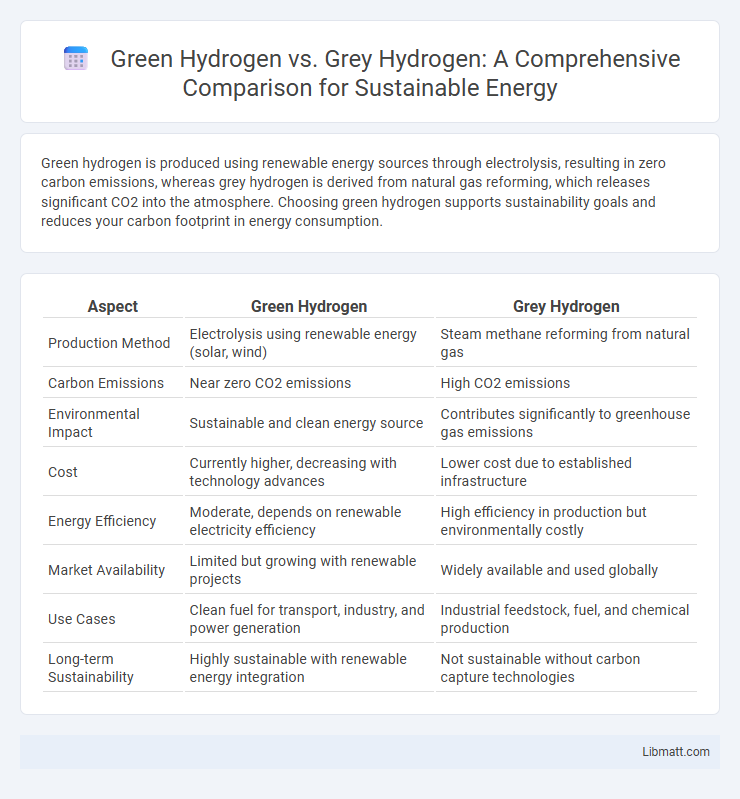Green hydrogen is produced using renewable energy sources through electrolysis, resulting in zero carbon emissions, whereas grey hydrogen is derived from natural gas reforming, which releases significant CO2 into the atmosphere. Choosing green hydrogen supports sustainability goals and reduces your carbon footprint in energy consumption.
Table of Comparison
| Aspect | Green Hydrogen | Grey Hydrogen |
|---|---|---|
| Production Method | Electrolysis using renewable energy (solar, wind) | Steam methane reforming from natural gas |
| Carbon Emissions | Near zero CO2 emissions | High CO2 emissions |
| Environmental Impact | Sustainable and clean energy source | Contributes significantly to greenhouse gas emissions |
| Cost | Currently higher, decreasing with technology advances | Lower cost due to established infrastructure |
| Energy Efficiency | Moderate, depends on renewable electricity efficiency | High efficiency in production but environmentally costly |
| Market Availability | Limited but growing with renewable projects | Widely available and used globally |
| Use Cases | Clean fuel for transport, industry, and power generation | Industrial feedstock, fuel, and chemical production |
| Long-term Sustainability | Highly sustainable with renewable energy integration | Not sustainable without carbon capture technologies |
Introduction to Hydrogen Energy
Hydrogen energy is a clean fuel alternative that can significantly reduce carbon emissions in various sectors. Green hydrogen is produced through electrolysis powered by renewable energy sources, resulting in zero greenhouse gas emissions. In contrast, grey hydrogen is generated by steam methane reforming of natural gas, releasing considerable amounts of CO2 and contributing to environmental pollution.
What is Green Hydrogen?
Green hydrogen is produced through the electrolysis of water using renewable energy sources such as wind, solar, or hydropower, resulting in zero carbon emissions. Unlike grey hydrogen, which is derived from natural gas through steam methane reforming and emits significant CO2, green hydrogen offers a sustainable and environmentally friendly alternative. This clean energy carrier is critical for decarbonizing industries like transportation, power generation, and heavy manufacturing.
What is Grey Hydrogen?
Grey hydrogen is produced through steam methane reforming (SMR), where natural gas reacts with steam to generate hydrogen and carbon dioxide as a byproduct. This process emits significant amounts of CO2, contributing to greenhouse gas emissions and environmental concerns. Unlike green hydrogen, grey hydrogen relies on fossil fuels and lacks carbon capture, making it less sustainable for long-term energy solutions.
Production Processes Compared
Green hydrogen is produced through electrolysis of water using renewable energy sources, resulting in zero carbon emissions during production. Grey hydrogen is derived from natural gas via steam methane reforming, releasing significant amounts of CO2 into the atmosphere. The stark contrast in carbon footprint makes green hydrogen a sustainable alternative to the carbon-intensive grey hydrogen process.
Environmental Impact of Green vs Grey Hydrogen
Green hydrogen produces zero carbon emissions by using renewable energy sources like wind or solar for water electrolysis, significantly reducing your carbon footprint compared to grey hydrogen. Grey hydrogen, derived from natural gas through steam methane reforming, emits large amounts of CO2, contributing heavily to greenhouse gas emissions and climate change. Choosing green hydrogen supports cleaner energy transitions and mitigates environmental damage caused by fossil fuel-based hydrogen production.
Economic Factors and Cost Analysis
Green hydrogen, produced via electrolysis powered by renewable energy, incurs higher initial costs due to expensive electrolyzers and limited large-scale infrastructure compared to grey hydrogen derived from natural gas through steam methane reforming. Over time, green hydrogen's operating costs may decrease as renewable energy prices fall and carbon pricing policies increase the true cost of grey hydrogen, which emits significant CO2 and requires carbon capture or mitigation expenses. Your strategic investment decisions should weigh these economic factors, considering long-term operational savings, evolving policy incentives, and environmental impact valuations.
Storage and Transportation Differences
Green hydrogen, produced via electrolysis using renewable energy, requires advanced storage solutions like high-pressure tanks and cryogenic storage to maintain its low-temperature liquid state, ensuring minimal energy loss during transportation. Grey hydrogen, derived from natural gas reforming, often benefits from existing pipeline infrastructure but releases carbon emissions during production and is generally stored under less stringent conditions. The transportation of green hydrogen faces higher costs due to its purity requirements and sensitivity to contamination, whereas grey hydrogen's established supply chain offers lower logistical challenges.
Scalability and Market Adoption
Green hydrogen, produced via electrolysis powered by renewable energy, faces scalability challenges due to high production costs and limited infrastructure but shows growing market adoption driven by decarbonization goals and government policies. Grey hydrogen, derived from natural gas with significant CO2 emissions, benefits from established production facilities and lower costs, resulting in widespread current market use but limited environmental appeal. Transitioning to green hydrogen requires substantial investment in electrolyzer technology and renewable capacity expansion to match the scalability and market penetration of grey hydrogen.
Role in Global Decarbonization
Green hydrogen plays a crucial role in global decarbonization by offering a clean energy source produced through electrolysis powered by renewable energy, resulting in zero carbon emissions. In contrast, grey hydrogen relies on fossil fuels like natural gas, emitting significant CO2 and hindering climate goals. Your transition to green hydrogen supports reducing greenhouse gas emissions and advancing sustainable energy systems worldwide.
Future Prospects and Policy Implications
Green hydrogen, produced through electrolysis using renewable energy, offers a sustainable pathway to decarbonize industries and transportation, aligning with global climate targets and energy transition policies. Grey hydrogen, derived from natural gas with significant CO2 emissions, faces increasing regulatory pressures and carbon pricing mechanisms that challenge its economic viability. Your investment decisions and policy frameworks must prioritize green hydrogen infrastructure development to support long-term environmental goals and energy security.
Green Hydrogen vs Grey Hydrogen Infographic

 libmatt.com
libmatt.com